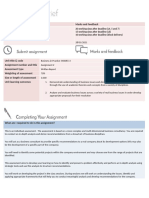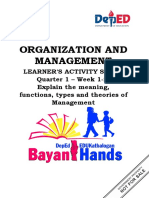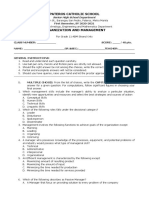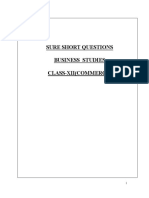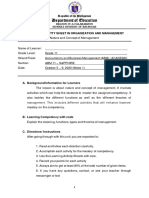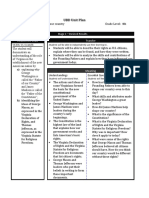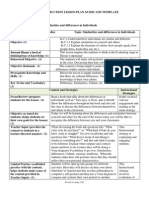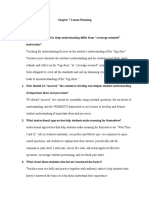Las Module 1
Uploaded by
Menchie D. LegaspiLas Module 1
Uploaded by
Menchie D. LegaspiDepartment of Education
Region V
Division of Camarines Sur
PINAGLABANAN HIGH SCHOOL
Goa, Camarines Sur
GRADE 11 – ORGANIZATION AND MANAGEMENT
LEARNING ACTIVITY SHEET
QUARTER 1 – MODULE 1: Definition and Functions of Management and the Different Types
of Management Theories
Name: _______________________________________________ Score: _______________________
I-Directions: Choose your answer from the given choices below. Write it in a separate answer sheet.
.
_____1. This deals with the monitoring of the company’s progress and using corrective measures if
necessary.
_____2. It involves mapping out how to realize a specific goal.
_____3. It involves manning in the organization.
_____4. Focuses on handling of people tactfully.
_____5. This determines what, who and how task is to be done.
_____6. This deals with the complexity and the relationship of organizations, workers, and
environment.
_____7. Believes that the best way toward gaining maximum productivity is through motivation,
structure and supporting employers.
II-Directions: Identify the term referred to in each number. Write it in a separate answer sheet.
1. Management as a ____________, refers to organizational process that includes strategic planning,
setting objectives, managing resources, deploying labor force, financial assets and measuring
results.
2. One of the management functions that ensure that all other functions are operating efficiently and
take corrective action if necessary is called __________________.
3. Management as a ___________, is used as singular collective noun (like group) which refers to a
discrete nature of grouping of managers or people in charge of running a company or organization.
4. This function of management is said to be the backbone of the organization, it is called _________,
where it helps to determine the task to be done, who and how the task needs to be performed.
5. Good interpersonal relationship is very essential that impact the job performance and efficiency of
an employee. This management function is called _____________.
6. _____________ theories believe that workers must be motivated, the structure and social
relationship among employees and managers must be observed for maximum productivity of the
workers.
7. This theory evolved in response to shift from handicraft to industrial production, it is called
_____________ theory.
Prepared by:
MENCHIE D. LEGASPI
Teacher II
Noted by:
RONALD P. ENCISO
Principal I
You might also like
- Grade 12 Organization and Management Week 1-390% (21)Grade 12 Organization and Management Week 1-325 pages
- Senior High School: Organization & Management Quarter I87% (23)Senior High School: Organization & Management Quarter I18 pages
- Organization and Management Module 1: Quarter 1 - Week 1No ratings yetOrganization and Management Module 1: Quarter 1 - Week 116 pages
- ABM11 - OrgMan11 - Q1 - Wk1 - Organization and Management 11 Meaning, Functions, Types and Theories of Management FINALNo ratings yetABM11 - OrgMan11 - Q1 - Wk1 - Organization and Management 11 Meaning, Functions, Types and Theories of Management FINAL4 pages
- Learning Activity Sheet No. 2: Title: Describing and Illustrating Different Angles100% (3)Learning Activity Sheet No. 2: Title: Describing and Illustrating Different Angles5 pages
- Reality Theory and Its Use in Group Counseling100% (1)Reality Theory and Its Use in Group Counseling7 pages
- organization and management 1st exam - CopyNo ratings yetorganization and management 1st exam - Copy4 pages
- Quarter 1 Week 1 - Organization and ManagementNo ratings yetQuarter 1 Week 1 - Organization and Management9 pages
- WLP - Organization and Management - Feb - 12 - 16 - 2024No ratings yetWLP - Organization and Management - Feb - 12 - 16 - 20249 pages
- Gas 11 Organization and Management q.1 2 1No ratings yetGas 11 Organization and Management q.1 2 111 pages
- Organization and Management: Quarter 1 - Module 1100% (2)Organization and Management: Quarter 1 - Module 116 pages
- Organization and Management Major ExaminationNo ratings yetOrganization and Management Major Examination3 pages
- Organization and Management: Definition and Functions of Management and The Different Types of Management TheoriesNo ratings yetOrganization and Management: Definition and Functions of Management and The Different Types of Management Theories3 pages
- Org Man - Module 1 Nature Concept of MGMT PDFNo ratings yetOrg Man - Module 1 Nature Concept of MGMT PDF5 pages
- Q1W1 DEFINITION, FUNCTIONS, TYPES and THEORIES of MANAGEMENTNo ratings yetQ1W1 DEFINITION, FUNCTIONS, TYPES and THEORIES of MANAGEMENT35 pages
- Org Man - Module 1 - Introduction To Management100% (3)Org Man - Module 1 - Introduction To Management5 pages
- HPGD2203 Education Management OUM TOPIC 1No ratings yetHPGD2203 Education Management OUM TOPIC 110 pages
- Examiners: Majoreen Osafroadu Amankwah Saviour Ayertey NubuorNo ratings yetExaminers: Majoreen Osafroadu Amankwah Saviour Ayertey Nubuor4 pages
- ADM Org Man Module 1 Meaning Functio Types and Theories of ManagementNo ratings yetADM Org Man Module 1 Meaning Functio Types and Theories of Management17 pages
- WEEK-2-ORGANIZATION-AND-MANAGEMENT-FIRST-SEMESTERrNo ratings yetWEEK-2-ORGANIZATION-AND-MANAGEMENT-FIRST-SEMESTERr5 pages
- Sure Short Questions Business Studies Class-Xii (Commerce)No ratings yetSure Short Questions Business Studies Class-Xii (Commerce)35 pages
- Organization & Management Abm 11 - St. Matthew Ms. Grace Ad Javido AY 2020 - 2021No ratings yetOrganization & Management Abm 11 - St. Matthew Ms. Grace Ad Javido AY 2020 - 20214 pages
- Department of Education: Learning Activity Sheet in Organization and Management100% (3)Department of Education: Learning Activity Sheet in Organization and Management15 pages
- Business 12th Chapterwise Chap 1 Indian PublishersNo ratings yetBusiness 12th Chapterwise Chap 1 Indian Publishers6 pages
- I. Introductory Concept: Organization and ManagementNo ratings yetI. Introductory Concept: Organization and Management6 pages
- The Skill Master's Guide: How to Improve Skills from the BeginningFrom EverandThe Skill Master's Guide: How to Improve Skills from the BeginningNo ratings yet
- Media and Information Literacy: A Practical Guidebook For TrainersNo ratings yetMedia and Information Literacy: A Practical Guidebook For Trainers19 pages
- Media and Information Literacy: A Practical Guidebook For TrainersNo ratings yetMedia and Information Literacy: A Practical Guidebook For Trainers9 pages
- Diagnostic Assessment and Treatment of Reading Difficulties - A Case Study of DyslexiaNo ratings yetDiagnostic Assessment and Treatment of Reading Difficulties - A Case Study of Dyslexia8 pages
- Theory Best Suited For: Learning Theory Comparison ChartNo ratings yetTheory Best Suited For: Learning Theory Comparison Chart1 page
- This Paper Was Presented at The International Seminar On HumanisticNo ratings yetThis Paper Was Presented at The International Seminar On Humanistic6 pages
- Part Iv: Development Plans: Bayog National High SchoolNo ratings yetPart Iv: Development Plans: Bayog National High School1 page
- UBD Unit Plan: Stage 1-Desired Results Established Goals TransferNo ratings yetUBD Unit Plan: Stage 1-Desired Results Established Goals Transfer6 pages
- Power & Political Behavior Nelson & QuickNo ratings yetPower & Political Behavior Nelson & Quick11 pages
- w08 Chapter 7 Lesson Planning Emily PopocaNo ratings yetw08 Chapter 7 Lesson Planning Emily Popoca2 pages
- Experiential Learning Project (ELP) : MBAZG634: Strategic Change ManagementNo ratings yetExperiential Learning Project (ELP) : MBAZG634: Strategic Change Management4 pages




